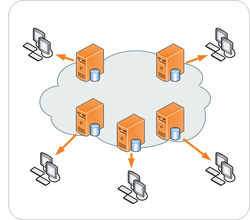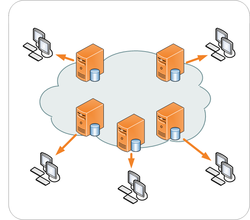
New media: serving your content fresh
Post Author:
CacheFly Team
Categories:
Date Posted:
October 15, 2013
Follow Us:
Have you ever watched a movie on Netflix or played a game on Xbox Live? If you have, you are engaging in the new media revolution. You may notice that the content you access on services like Netflix and Xbox Live can be streamed quickly to any device reliably, no matter where you are. As of June 30, 2013, Netflix reported having 37.6 million customers in the U.S. alone who stream volumes of content on a daily basis. So how do companies like Netflix handle so many simultaneous requests for high-definition video and other content? New developments in cloud-based computing and content delivery networks (CDNs) power the ability to serve content on-demand.
Streaming content: A quick sketch
To illustrate this process, we will stick with Netflix as an example. While you watch an episode of your favorite television series on its platform, Netflix is making a number of logical decisions behind the scenes in order to serve the requested multimedia quickly and reliably:
- The balancing act: When you request multimedia, Netflix assigns your device to a particular node or server. Netflix’s network has an elastic number of servers that increases or decreases with demand. If the Netflix network is overburdened, the network automatically adjusts and adds more nodes to serve content.
- Getting as close as possible: Netflix can tell where in the world you are accessing content from. Your IP address, a numerical address which identifies your device on the Internet, reveals your general geographic area. Netflix reroutes your request to the server physically closest to you in order to provide the best possible performance.
The technology: Caching
Large content distribution companies like Netflix need servers located around the world at intersections called global peering points. These peering points are the most efficient location on the Internet from which to serve content to a particular geographic area. Distributing new media globally requires a service that easily facilitates the storage and distribution of media-rich content from these points.
This service is called a content delivery network (CDN). A CDN can distribute content geographically and also keeps a cache of the most-accessed content. Using a CDN ensures that content will be seamlessly delivered to a user, without lag or interruption. A popular television show like Breaking Bad, for example, would be stored globally and seamlessly distributed though Netflix’s CDN to any requesting device, making sure consumers are satisfied with the service and come back for more episodes.
Photo credit: Wikimedia Commons
Product Updates
Explore our latest updates and enhancements for an unmatched CDN experience.
Request a Demo
Free Developer Account
Unlock CacheFly’s unparalleled performance, security, and scalability by signing up for a free all-access developer account today.
CacheFly in the News
Learn About
Work at CacheFly
We’re positioned to scale and want to work with people who are excited about making the internet run faster and reach farther. Ready for your next big adventure?






